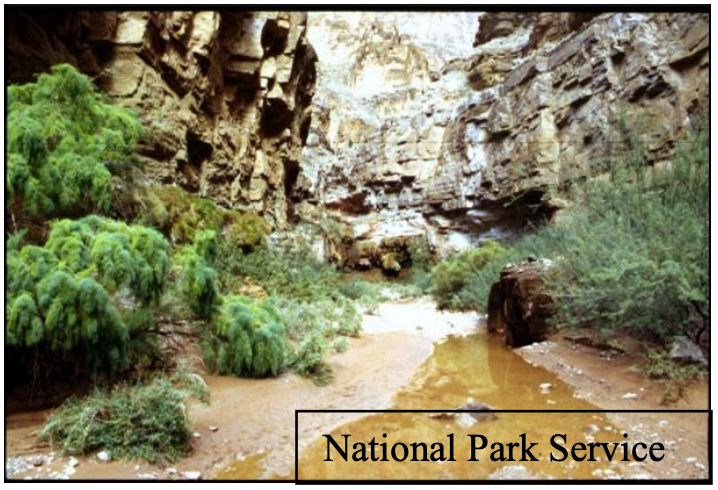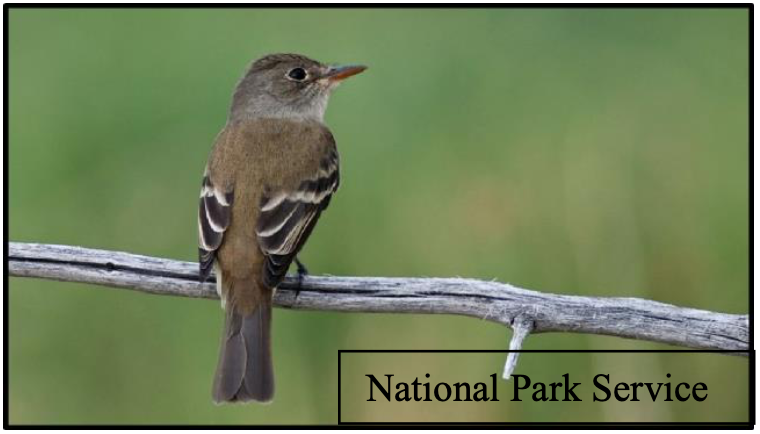Based on the presentation “When invasive species become habitat for endangered ones” by Mary Clapp
In 1963, the opening of Glen Canyon Dam just upstream of Grand Canyon National Park began providing water, electricity, and recreation to the rapidly growing population in the American southwest. After over 50 years since its creation, the Colorado River within the Grand Canyon has seen significant changes affecting the river landscape and subsequently the plants and animals that live there. These unforeseen ecologic effects, have driven a number of scientists to investigate the effects of Glen Canyon Dam on a variety of plant and animal species, such as Tamarisk and the Southwest Willow Flycatcher.
Prior to the creation of Glen Canyon Dam, the Colorado River was wild and untamed. As snow melted in Colorado’s Rocky Mountains, the relatively warm, sediment rich water roared through the Grand Canyon. The same river that carved one of the greatest canyons in the world. These flows scoured large amounts of material in the Grand Canyon, creating an ever changing environment for some of the unique species living in this area. However, the dam brought about many changes. Glen Canyon Dam limited water flows through the canyon capturing the largest floods behind the dam for water storage. Dirt, mud, and silt piled up behind the dam, leaving sediment-starved, crystal- clear water flowing through the Grand Canyon. Water temperature below the dam decreased substantially as the water that did pass through Glen Canyon Dam was drained from the bottom of the cold lake it stored behind it.

The post-dam Colorado River was more stable with less scour and erosion, bringing with it a host of plants that previously did not (and could not) occupy the sandy banks within the Grand Canyon. The most notable being Tamarisk. Tamarisk is a non-native, invasive woody plant that followed the path of human disturbance from Glen Canyon Dam to the heart of the Grand Canyon. Large efforts have been put forth to eradicate Tamarisk as it crowds out native vegetation limiting plant diversity along the river. Scientists have also argued that Tamarisk causes increases in fire risk, flood potential, and drought stress. On the other hand, Tamarisk does provide on large benefit to Colorado River ecology: increased nesting grounds for an endangered bird species.

The Southwest Willow Flycatcher was once abundant in the Grand Canyon, however populations began to decline and in 1995 they were listed as Federally Endangered. As Tamarisk spread along the river, scientists began to notice that more and more flycatchers were nesting in Tamarisk. Scientists in 2005 found that there were no negative effects on flycatchers nesting in Tamarisk when compared to native plant species. It seems that Tamarisk, a notoriously “evil” plant within the Grand Canyon ecosystem, has actually been providing benefits to an endangered species of bird, causing a small dilemma in the field of conservation ecology. A somewhat contrary study, recently found that a larger abundance and diversity of birds are seen stopping over native (less Tamarisk dominated) vegetation. This complex relationship exemplifies the complexities in human alteration and modification of natural habitats. The question begs to be asked: is it possible to recreate a natural habitat, in an area that is fundamentally changed by the impacts of Glen Canyon Dam.
In attempt to address all of these issues, scientists have looked to a non-native beetle to help solve some of the problems. Through a process known as “biocontrol” scientists use the beetle to eat and kill the leaves of the Tamarisk plant, with the hopes that Flycatchers can still nest in the twigs of the Tamarisk, while Tamarisk populations will decline, leaving room for more native plants to repopulate the region. It remains to be seen if this method is successful. Beetles have yet to be introduced within the Grand Canyon National Park boundary. Conservation efforts within the park still rely on direct eradication of Tamarisk through manual removal and burning of stumps.
So what is the moral of this story? Clearly there is an extremely complex and sensitive relationship between plants and animals within the Grand Canyon. This all becomes exponentially more complex as humans get involved. Do the negative effects of Tamarisk outweigh the positive effects it provides for Southwestern Willow Flycatchers? What about introducing a non-native beetle to solve a non-native plant problem? Will there be more unforeseen effects as the beetles spread? Restoration of the natural habitat is important for maintaining healthy ecosystems. But who is actually the invasive species in this story? Tamarisk? Or humans? Successfully restoring this region to its natural habitat is extremely tricky and will likely revolve around the elephant in the room, or rather the large concrete structure that is Glen Canyon Dam.
